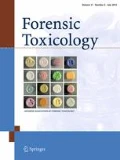Abstract
Shortly after we reported the seizure of the amphetamine derivative N,α-diethylphenethylamine (NADEP) as bulk powder, we have identified NADEP in preworkout supplements branded as “Craze” and sold via the Internet. A gas chromatography–mass spectrometry method was validated and used to quantitate NADEP in the supplements. The authentic NADEP sample of the previous study was used as the reference standard for quantitative analysis after purity assay using quantitative nuclear magnetic resonance spectroscopy. Using these methods, NADEP concentrations in two Craze supplements (Berry Lemonade Flavor and Candy Grape Flavor) were quantitated as 0.40 and 0.44 %, respectively. With the label suggesting a serving size of 5.3–5.8 g, this was equivalent to about 23 mg of NADEP. NADEP was patented in 1988 by Knoll Pharmaceuticals with claims of psychoactive effects (e.g., cognitive enhancement and pain tolerance). For unknown reasons, the compound was never developed into a medicine, and important data about its effects and risks are lacking. Nevertheless, the patent suggested an intended oral dose range of 10–150 mg with a target of 30 mg. Therefore, it could be assumed that NADEP was added to the supplements intentionally for its pharmacological effects without adequate labeling. Because NADEP is a structural analog of methamphetamine in which the two methyl groups are only replaced by ethyl groups, it is possible that the toxicity of NADEP is similar to that of methamphetamine. Thus, supplements containing NADEP should be removed from the market immediately. In countries where NADEP is not regulated as a controlled substance, it should be enforced under the Medicines Act.




Similar content being viewed by others
References
Lau G, Lo DST, Yao YJ, Leong HT, Chan CL, Chu SS (2004) A fatal case of hepatic failure possibly induced by nitrosofenfluramine: a case report. Med Sci Law 44:252–263
WADA (2013) The 2013 prohibited list. World Anti-Doping Agency, Montreal
Zhang Y, Woods RM, Breitbach ZS, Armstrong DW (2012) 1,3-Dimethylamylamine (DMAA) in supplements and geranium products: natural or synthetic? Drug Test Anal 4:986–990
Kelleher C, Christie R, Lalor K, Fox J, Bowden M, O’Donnell C (2011) An overview of new psychoactive substances and the outlets supplying them. National Advisory Committee on Drugs (NACD), Dublin
Thomas JE, Munir JA, Mclntyre PZ, Ferguson MA (2009) STEMI in a 24-year-old man after use of a synephrine-containing dietary supplement: a case report and review of the literature. Tex Heart Inst J 36:586–590
Lee J, Choe S, Choi H, Heo S, Kim E, Kim H, Bang E, Chung H (2013) Identification of N-ethyl-α-ethylphenethylamine in crystalline powder seized for suspected drug trafficking: a research chemical or a new designer drug? Forensic Toxicol 31:54–58
Gadape HH, Parikh KS (2011) Quantitative determination and validation of metformin hydrochloride in pharmaceutical using quantitative nuclear magnetic resonance spectroscopy. E-J Chem 8: 767–781. http://dx.doi.org/10.1155/2011/46898
Gadape HH, Parikh KS (2011) Quantitative determination and validation of pioglitazone in pharmaceutical using quantitative nuclear magnetic resonance spectroscopy. J Chem Pharm Res 3:649–664
Miller JN, Miller JC (2005) Statistics and chemometrics for analytical chemistry, 5th edn. Pearson Education, Harlow
Peters FT, Drummer OH, Musshoff F (2007) Validation of new methods. Forensic Sci Int 165:216–224
József K, Antal S, Éva S, Éva S, Zoltán T, Károly M, János B (1988) New psychostimulant agent. International application published under the patent cooperation treaty (PCT). World Intellectual Property Organization (WIPO), Publication No. WO 88/02254
Noggle FT, Clark CR, Pitts-Monk P, DeRuiter J (1991) Liquid chromatographic and mass spectral analysis of 1-phenyl-2-butanamines: homologues of the amphetamines. J Liq Chromatogr 14:1393–1408
Ricaurte GA, DeLanney LE, Irwin I, Witkin JM, Katz JL, Langston JW (1989) Evaluation of the neurotoxic potential of N, N-dimethylamphetamine: an illicit analog of methamphetamine. Brain Res 490:301–306
Junet R (1956) Ethylamphetamine in the treatment of obesity (in French). Praxis 45:986–988
Oberlender R, Nichols DE (1991) Structural variation and (+)-amphetamine like discriminative stimulus properties. Pharmacol Biochem Behav 38:581–586
Nichols DE (1986) Differences between the mechanism of action of MDMA, MBDB, and the classic hallucinogens. Identification of a new therapeutic class: entactogens. J Psychoact Drugs 18:305–313
Suzuki O, Hattori H, Asano M, Oya M, Katsumata Y (1980) Inhibition of monoamine oxidase by d-methamphetamine. Biochem Pharmacol 29:2071–2073
Nieddu M, Trignano C, Burrai L, Pirisi MA, Boatto G (2013) Cross-reactivities of 41 new amphetamine designer drugs to EMIT® immunoassays. Forensic Toxicol 31:133–137
Pirisi MA, Nieddu M, Burrai L, Carta A, Briguglio I, Baralla E, Demontis MP, Varoni MV, Boatto G (2013) An LC–MS–MS method for quantitative analysis of six trimethoxyamphetamine designer drugs in rat plasma, and its application to a pharmacokinetic study. Forensic Toxicol 31:197–203
Nakazono Y, Tsujikawa K, Kuwayama K, Kanamori T, Iwata YT, Miyamoto K, Kasuya F, Inoue H (2013) Differentiation of regioisomeric fluoroamphetamine analogs by gas chromatography–mass spectrometry and liquid chromatography–tandem mass spectrometry. Forensic Toxicol 31:241–250
Zaitsu K, Miyagawa H, Sakamoto Y, Matsuta S, Tsuboi K, Nishioka H, Katagi M, Sato T, Tatsuno M, Tsuchihashi H, Suzuki K, Ishii A (2013) Mass spectrometric differentiation of the isomers of mono-methoxyethylamphetamines and mono-methoxydimethylamphetamines by GC–EI–MS–MS. Forensic Toxicol 31:292–300
Acknowledgments
This study was supported by funding from the National R&D program of the Ministry of Education, Science, and Technology (2012-0009836) and the National Forensic Service of Korea. The authors thank H.J. Kim and Dr. E.J. Bang of the Korean Basic Science Institute for their assistance with the NMR measurements.
Conflict of interest
There are no financial or other relations that could lead to a conflict of interest.
Author information
Authors and Affiliations
Corresponding author
Rights and permissions
About this article
Cite this article
Lee, J., Venhuis, B.J., Heo, S. et al. Identification and quantitation of N,α-diethylphenethylamine in preworkout supplements sold via the Internet. Forensic Toxicol 32, 148–153 (2014). https://doi.org/10.1007/s11419-013-0205-6
Received:
Accepted:
Published:
Issue Date:
DOI: https://doi.org/10.1007/s11419-013-0205-6




